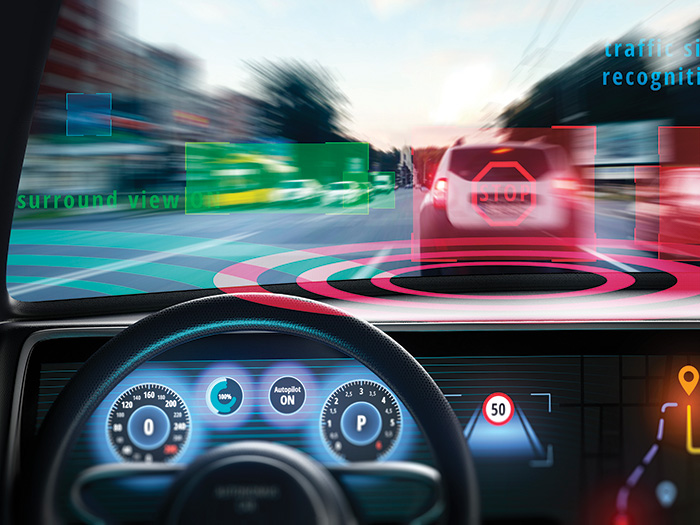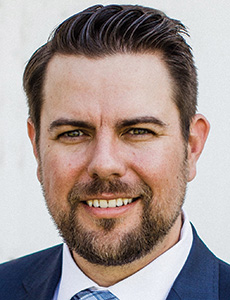Predict & Prevent™: What Commercial Fleet Owners Ought to Know About Telematics and Other Tech Tools That Target Losses

If you’d asked him ten years ago what technology would revolutionize road safety, Matt Moore, senior vice president with the Highway Loss Data Institute, probably would have said self-driving cars.
Back then, “everyone was writing about how automated driving is going to be the end of the need for automobile insurance,” Moore said.
But predictions are just educated guesses. The promise of vehicles that run on autopilot while the driver monitors their progress and intercedes only in an emergency “have not yet come to pass and the earliest results are saying it might not come to pass,” according to Moore. In fact, 400 vehicles with self-driving capabilities were involved in crashes, between July 2021 and May 2022, per data from the The National Highway Traffic Safety Administration.
While autonomous vehicles haven’t negated the need for auto-insurance just yet, telematics and crash avoidance technologies are making commercial fleets safer by detecting trends in driver behavior, aiding risk managers in making targeted safety programs and warning drivers in situations where a crash might be imminent.
These tools are actually acting on the promise of self-driving vehicles by predicting and preventing accidents. Despite the benefits, commercial fleets are slow to adopt these technologies due to a lack of incentives from insurers and suspicions from drivers who are concerned about how their privacy is affected by cab-facing cameras.
Predicting Accidents: How Telematics Shift Driver Behavior
A combination of telecommunications, the electronic transmission of information over distances, and informatics, the science of how to use data, telematics is the use of tracking devices that measure speed, sharp turns, harsh acceleration and braking, driver behaviors and vehicle condition. The purpose is simple: to save lives by reducing motor vehicle accidents.
“It’s all about saving lives and reducing as many collisions as possible,” said Matthew Ison, head of sales for North America at VisionTrack, a telematics service provider. VisionTrack was founded by Simon Marsh, a former commercial fleet owner who wanted to make his own vehicles safer.
“When you’re able to decrease that risky driver behavior, obviously the number of claims or incidents are going to decrease as well.”
Fleet telematics break down into three key categories: those focused on driver behavior, those dedicated to tracking drowsy and distracted driving and those that target the vehicle’s condition. Tools that measure speeding and harsh braking, for instance, are focused on driver behavior.
A cab facing camera equipped with artificial intelligence that watches for drooping eyelids or an infrared sensor that detects when a driver takes their hands off the wheel are targeting distracted driving.
“Advancements within cab technology are now allowing the drivers to try to self-correct in the moment,” said Brandon Leininger, CSP, loss control lead, transportation and energy, Lockton Companies.
“There are technologies out there using artificial intelligence that are monitoring eye movement and blinking and head drooping,” added Jay Gnadt, senior vice president, data analytics and risk control consulting, Lockton Companies, “that will trigger an alert for a driver or the driver’s manager to intervene if it looks like they’re becoming fatigued or they’re distracted.”
On the vehicle end, telematic systems may monitor issues like engine condition or tire pressure, sending alerts to a risk manager if threadbare or under-inflated tires are increasing the risk of accidents, for instance.
“That technology enables risk and safety managers with companies that have commercial fleets to have visibility into the health of the vehicle and visibility to how the vehicles are being driven,” said Thomas Erdman, executive vice president business development and channels for the telematics provider Azuga, A Bridgestone Company.
Commercial fleets often access these tools through third-party software vendors or through their insurers, who may offer incentives for participating in a telematics program. They can be as complex as adding cameras and installing software in vehicles or as simple as adding an app to a driver’s company cell phone that uses GPS data to track speeding or distracted driving behaviors. These apps can also lock a driver’s phone while the vehicle is moving, resulting in “a large reduction in all distracted driving accidents,” Anderson said.
“It’s not as precise, but the cell phones can measure a lot. It can measure speeding and crash detection,” added Christina Villena, CSP, ARM, vice president of risk solutions at The Hanover Insurance Group.
Telematics are resulting in massive reductions in risky behavior and reducing claims costs. VisionTrack says they tend to see an 80% reduction in risky behavior, a 40% decrease in at-fault collisions and 24% reduction in claims frequency when their technologies are implemented.
Ryan Anderson, CRM, CSP, risk management expertise specialist, digital innovation, with Amerisure Insurance, says he typically sees a 30% reduction in claims frequency and severity for fleets using telematic solutions.
Sorting Through Telematics Data
Telematics systems may be transforming how commercial fleet risk managers approach safety, but they can be difficult to use. These systems collect vast amounts of data, making it hard to determine what is useful and what can be tossed out. Some fleets may be working with multiple telematic vendors, complicating the data sorting process.
“If you’re the carrier and you have thousands of insureds that are leveraging this telematics platform, how do you make sense of all of that data?” Erdman said.
“Not all data is collected equally,” Villena added. “When you have several manufacturers the key is normalizing it.”
Currently there are several different solutions for risk professionals to sort through the mountain of data collected by telematics systems. Some telematics companies offer services where teams view the data and organize it for commercial fleet clients.
“There’s definitely things like managed services where they have just teams and teams of hundreds of people that are doing nothing but combing through video footage and trying to find the right evidence or data to send to the appropriate fleet managers or claims managers,” Ison said.
Others are using artificial intelligence to comb through telematic data and send that information to risk managers. “Through the power of AI and deep learning technologies we are going to be able to completely automate the process within eight seconds of an incident occurring,” Ison said. “We have the ability to filter out false positives at a 98.9% accuracy rate.”
Once the data is sorted into a usable format, risk managers can create customized safety training for their fleets. Azuga’s system will automatically send training videos to drivers who have specific infractions.
“If a driver is in the risk zone, then they will automatically get training videos pushed to them that are based on their riskiest driving behavior that prior week,” Erdman said.
Risk managers can also use the data to create their own custom safety plans and to plan safer routes. Rather than offer generic driver training, they can target the particular pain points for their drivers and their routes. If a particular highway on-ramp causes a large number of drivers to brake harshly, for instance, a company can require its CDLs to take a different, safer route.
“We always recommend setting up a formal written program that defines the expectations of drivers and safe driving behavior,” Anderson said.
“Program administrators will look at the footage and they’ll see that it’s a poorly planned roadway,” added Chris Black, senior vice president, risk control consulting, Lockton Companies.
“They might adjust their operating protocols there to avoid a particular intersection or part of the road.”
Preventing Accidents: Crash Avoidance Technologies
Beyond telematics, crash avoidance technologies are delivering on the promise of self-driving cars by preventing accidents in the moment. Automatic front and rear braking systems can prevent accidents during slow-moving situations, when a driver could get distracted and accidentally back into something, or when a pedestrian unexpectedly walks in front of the vehicle on a busy city street.
Blind spot notification systems and cameras that offer views a driver wouldn’t normally be able to access are critical to preventing collisions.
“Just using forward facing cameras is not going to cut it, only between 30-35% of incidents take place in the forward-facing camera’s field of vision,” Ison said, “there’s a lot of real estate around the rest of that vehicle that’s not being addressed, the new uptake we’re seeing is in 360-degree cameras.”
Unlike telematics software, which is often installed by a third-party vendor after a vehicle is purchased, crash avoidance technologies are often added to vehicles by their manufacturers. As commercial fleets upgrade to newer cars and trucks, they’re more likely to include front and near collision warning and blind spot monitoring systems.
“The vast majority of vehicle manufacturers in the U.S. are now equipping vehicles with these systems as standard equipment,” Moore said.
How Common Are Telematics in Commercial Fleets?
Overall, usage of telematics and crash avoidance technology in commercial fleets has lagged behind the personal vehicle market where insurers have long incentivized the use of these technologies, but that is slowly changing.
“We’re seeing more and more companies get involved in using telematics for not just onboard computers but also the cameras in the trucks — forward facing cameras and in cab facing cameras,” said Chris O’Neill, risk control associate, AXA XL
The technologies are most common in larger fleets that have been pinched by rate and premium increases in recent years as carriers struggle to make the commercial auto segment profitable. “They’re behind the curve if they do not have that implemented,” Anderson said.
Smaller to medium sized fleets might be a bit behind on adoption, however: “If it’s a smaller fleet, those management teams probably haven’t dealt with as much pain around their premiums,” Anderson explained.
One hurdle to getting smaller fleets to adopt telematics and crash avoidance technologies is the fact that many don’t consider themselves transportation companies. A pizza delivery business, for instance, might predominantly consider itself a restaurant, though they have drivers on the road delivering food in company cars.
“We’re trying to get people that don’t think of themselves as a trucking or transportation company. They think of themselves as a service company, but yet, they’re running some pretty large fleets,” O’Neill said.
Carriers could help improve uptake in this segment by incentivizing the use of telematics and crash avoidance technologies as is common in personal auto. “On the personal line side where you can get 10, 12, 15% discounts from a number of carriers,” Gnadt said.
“We’d like to see the commercial insurance market be much more on par with the personal insurance market.”
“Insurance companies have really not incentivized the use of advanced technologies very well,” Black added. “There are no credits given for upgrading your vehicles to smarter vehicles that have better sensors. There are no credits given for a properly implemented in-vehicle system or camera system, but the insurance companies are reaping the benefits of this. They will state that it’s a consideration for pricing, but not offer an upfront discount or cost sharing.”
Some carriers are already doing this. Anderson said Amerisure has started offering a usage-based insurance policy based on data from telematic devices. Others, like AXA XL are helping risk managers meet telematics providers.
“We try to match them up with technology providers,” O’Neill said. “It’s kind of like a blind date. We introduce them to the provider and hopefully they come to an agreement.”
Getting Drivers on Board
Part of the reason commercial fleets have been slower to adopt telematic and crash avoidance solutions compared to personal auto is driver hesitancy. Commercial drivers may be concerned about the data collected by cab facing cameras and other telematic tools and whether their company is doing enough to protect their privacy when implementing these technologies.
One way risk managers can get drivers on board with these technologies is through educating them on the safety and litigation benefits. When cameras capture what happens during a crash a driver may be more likely to be exonerated.
“With a properly installed and administered system, you’re getting a massive amount of exonerations from accidents,” Black said. “Lawsuits that you would have settled for thousands of dollars, but you’re settling at some point to avoid going to court and racking up legal fees are now completely off the books.”
“I’ve personally observed past claims in which the claimants were dropped by their plaintiff attorneys after they review the footage of what really took place and they realize they don’t have a case,” Leininger added.
Another way to get drivers on board is through incentivizing the use of these technologies. Rewards for the safest driver — based on the findings of telematic data — can help make these tools more appealing. Prizes, like iPads or a meeting with the company CEO, can help get workers excited about telematics.
“We have seen greater success when they’re able to tie it into some type of gamification,” Villena said.
Anderson agrees that gamification is key to helping drivers embrace telematic systems. Sometimes, he says, prizes aren’t needed. A company leaderboard that names the safest driver can tap into competitive human nature, causing CDLs to compete against one another.
“There’s a lot of different ways to incentivize workers,” Anderson said.
“You see almost this gamification of the technology coming in because the driver will come in to check his score and go, ‘man, this other driver beat me.’ This week, they’re actually competing to see who can get the better score.”
Some companies have so much success winning drivers over with these strategies that they don’t want to be on the road without telematics: “If you tell a driver he’s going to drive a spare truck that doesn’t have telematics for a week, he can become very upset because he doesn’t have telematics in his truck anymore,” O’Neill said.
Of course, vehicle safety starts with the driver. If they’re not on board or don’t understand how to respond to alerts from telematic or crash avoidance technologies, they won’t reduce the number of accidents.
“The most important piece of safety technology inside the cab is the driver. If the driver doesn’t understand how these technology systems really work, if they don’t understand how to engage with them, it typically leads to frustration, possibly quitting, leading to additional challenges for the company as well,” Leininger said. &











